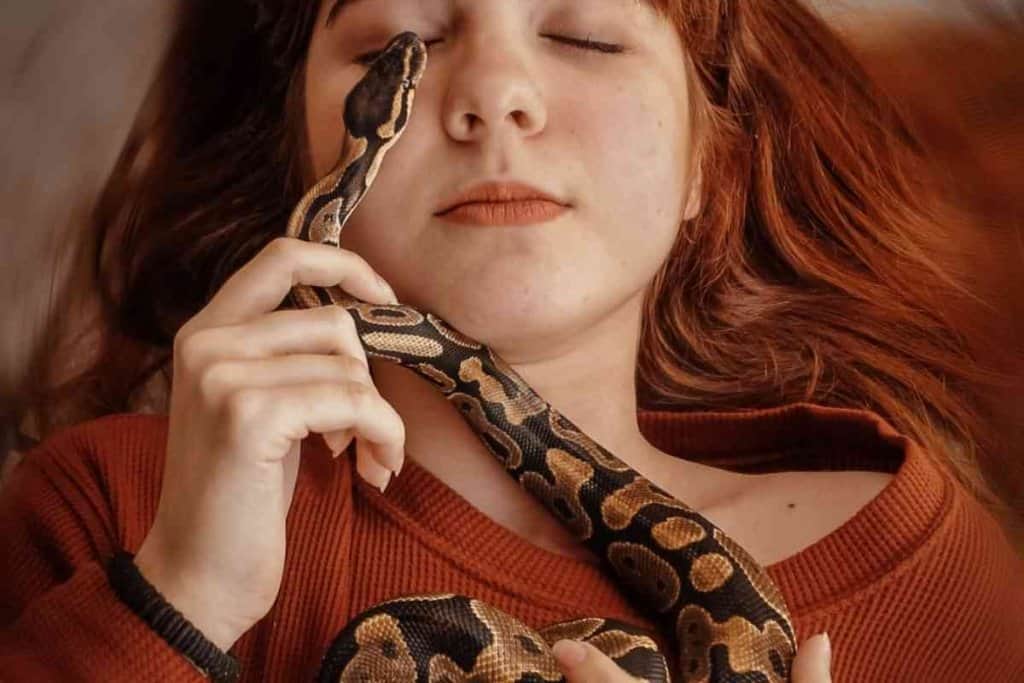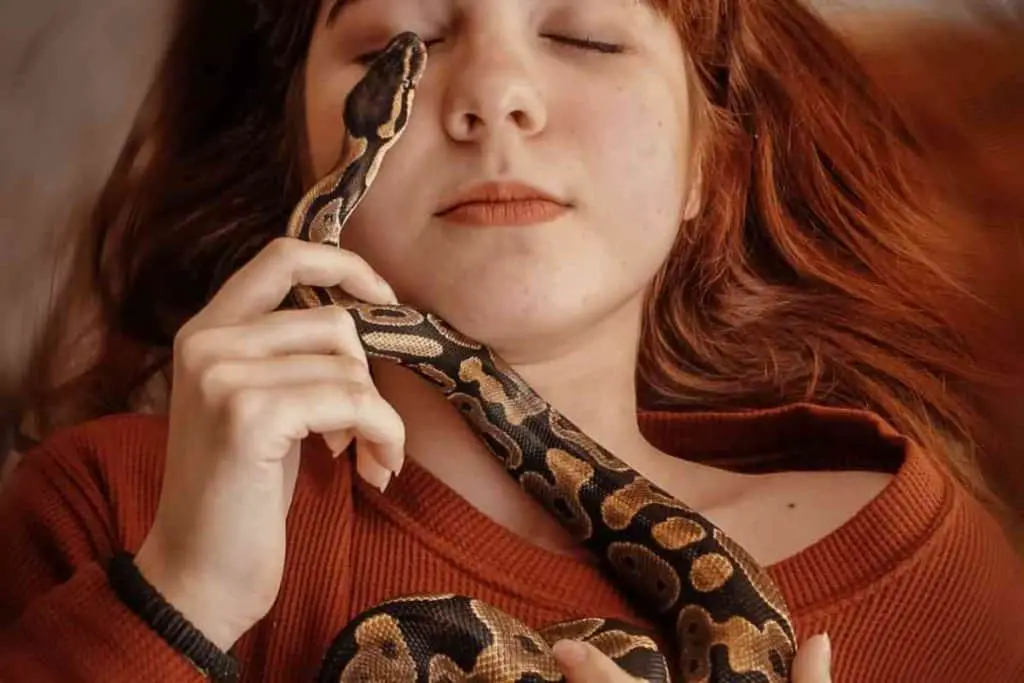Snakes have always been a fascinating creature for mankind, but their unique eating habits raise some interesting questions. One of the most common inquiries is whether it’s safe to handle a snake after it has eaten.
While some may believe that a snake should not be handled after a meal, others argue that it’s safe as long as you handle them carefully. Let’s explore both sides of the debate and discover what the experts have to say about holding a snake after it eats.

Can You Hold a Snake After It Eats?
What Happens to a Snake After It Eats?
Snakes are carnivorous creatures that swallow their prey whole. When a snake eats, the prey is swallowed whole into their stomach. The digestion process starts immediately, and the stomach muscles contract to break down the prey. The whole process takes about three to four days, depending on the size of the prey. During this time, the snake will not be able to move around as much as it usually would. Its metabolism slows down, and it will become sluggish and less active.
The Risks of Holding a Snake After It Eats
It is not recommended to hold a snake after it eats for several reasons. Firstly, the snake is in the process of digesting its food, and any sudden movements or handling can cause it to regurgitate its meal. This process is harmful to the snake as it can cause damage to its esophagus and stomach lining. Secondly, the snake may become aggressive and defensive if it feels threatened or uncomfortable while digesting its food. This behavior is natural as the snake is vulnerable during this time and needs to protect itself.
The Benefits of Waiting to Hold a Snake
It is best to wait for the snake to digest its food completely before handling it. Once the digestion process is complete, the snake will be more active and alert, and its movements will be more natural. This will also reduce the risk of the snake regurgitating its food, which can be fatal for the snake. It is also important to wait for the snake to be in a comfortable and stress-free environment before handling it. This will help to ensure both the snake’s and handler’s safety.
The Vs of Holding a Snake Before and After Eating
Handling a snake before it eats is generally safer as the snake is more active and alert. However, it is important to note that snakes have different temperaments, and some may become aggressive and defensive regardless of whether they have eaten or not. It is always best to handle a snake in a calm and stress-free environment and to approach it slowly and gently.
How to Care for a Snake After It Eats
After a snake has eaten, it is important to provide it with a stress-free environment to aid in digestion. This can be achieved by keeping the snake in a warm and quiet area away from any distractions. It is also important to ensure that the snake has access to fresh water at all times. Feeding your snake a proper diet and providing it with the correct temperature and humidity levels will also help with digestion and overall health.
The Do’s and Don’ts of Feeding a Snake
Do’s:
– Feed your snake a diet that is appropriate for its species and size.
– Provide your snake with fresh water at all times.
– Ensure the temperature and humidity levels in the enclosure are correct.
– Monitor your snake’s feeding habits and adjust its diet accordingly.
Don’ts:
– Feed your snake live prey as this can be dangerous for both the snake and the prey.
– Overfeed your snake as this can lead to obesity and health problems.
– Handle your snake immediately after it eats.
– Disturb your snake while it is digesting its food.
Conclusion
In conclusion, it is not recommended to hold a snake after it eats. It is best to wait for the digestion process to complete before handling the snake to reduce the risk of regurgitation and injury. Providing your snake with a stress-free environment and proper care will aid in digestion and overall health. Remember to follow the do’s and don’ts of feeding a snake to ensure its safety and well-being.
Frequently Asked Questions
Can You Hold a Snake After It Eats?
Yes, you can hold a snake after it eats, but it is not recommended. Snakes need time to properly digest their food, and handling them can cause stress and regurgitation. Regurgitation is when the snake vomits up its meal, which can be harmful to its health.
If you must handle your snake after it eats, wait at least 48 to 72 hours after its last meal. This allows enough time for the snake to digest its food properly. Additionally, avoid handling the snake near its enclosure or feeding area, as this can also cause stress and regurgitation.
What Happens If You Hold a Snake After It Eats?
Holding a snake after it eats can cause stress and regurgitation. Stress can cause the snake to become agitated, which can lead to vomiting up its meal. Regurgitation is harmful to the snake’s health, as it can cause dehydration and malnutrition.
In addition to stress and regurgitation, handling a snake after it eats can also cause physical harm to the snake. The snake’s body is working hard to digest its meal, and any sudden movements or pressure can cause damage to its internal organs.
Can You Touch a Snake After It Eats?
It is not recommended to touch a snake after it eats. Snakes need time to properly digest their food, and handling them can cause stress and regurgitation. Regurgitation is when the snake vomits up its meal, which can be harmful to its health.
If you must touch your snake after it eats, wait at least 48 to 72 hours after its last meal. This allows enough time for the snake to digest its food properly. Additionally, avoid touching the snake near its enclosure or feeding area, as this can also cause stress and regurgitation.
How Long Should You Wait to Handle a Snake After It Eats?
You should wait at least 48 to 72 hours to handle a snake after it eats. This allows enough time for the snake to properly digest its meal. Handling a snake before it has properly digested its meal can cause stress and regurgitation, which can be harmful to its health.
Additionally, avoid handling the snake near its enclosure or feeding area, as this can also cause stress and regurgitation. It is important to give your snake time to rest and digest after it eats.
What Are the Signs That a Snake Is About to Regurgitate?
There are several signs that a snake is about to regurgitate, including lethargy, loss of appetite, and vomiting. The snake may also appear bloated or uncomfortable. If you notice any of these signs, it is important to leave the snake alone and allow it to rest.
Regurgitation is harmful to the snake’s health, as it can cause dehydration and malnutrition. If your snake regurgitates its meal, wait at least a week before offering it food again. Additionally, ensure that the snake’s enclosure is at the appropriate temperature and humidity levels, as these factors can affect digestion.
How Often Can You Handle Your Snake?
In conclusion, it is not recommended to hold a snake after it eats. Snakes require time to digest their food properly, and any activity or stress can interfere with this process. Attempting to handle a snake in this state can also put you in danger, as the snake may become defensive or agitated.
It is important to remember that snakes are living creatures and should be treated with respect. If you are unsure of how to properly care for a snake, seek advice from a reputable source or professional.
Overall, while it may be tempting to handle your pet snake after it eats, it is best to let them rest and recover in their enclosure. This will ensure their health and happiness, and also prevent any unnecessary danger for both you and your snake.


